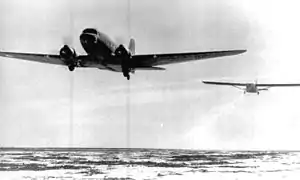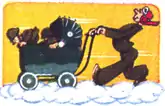51st Troop Carrier Squadron
The 51st Troop Carrier Squadron is an inactive United States Air Force unit. Its last assignment was with the Naples Air Force General Depot at Ciampino Airport, Italy, where it was inactivated on 9 March 1946. The squadron was activated in the spring of 1942 as the 51st Transport Squadron, when the 62d Transport Group expanded from three to four squadrons. After training in the United States, the squadron moved briefly to England, then to the Mediterranean Theater of Operations, where it served until V-E Day. It remained in Italy after the war until inactivating.
| 51st Troop Carrier Squadron | |
|---|---|
 C-47 Skytrains and Waco CG-4 gliders | |
| Active | 1942-1946 |
| Country | |
| Branch | |
| Role | Airlift |
| Engagements | Mediterranean Theater of Operations |
| Insignia | |
| 51st Troop Carrier Squadron emblem (approved 20 April 1944)[1] |  |
History
Activated in June 1942 as a I Troop Carrier Command Douglas C-47 Skytrain troop carrier squadron, trained in the United States until being deployed to England. Assigned to VIII Air Support Command, Eighth Air Force in October 1942.
Trained briefly in England until the Operation Torch landings in North Africa during November 1942. Was reassigned to Twelfth Air Force and moved to Tafaraoui Airfield, Algeria on 15 November 1942. The squadron's aircraft flew supplies to front-line units in Algeria and Tunisia during the North African Campaign as soon as suitable landing strips were available and evacuated casualties back to rear area field hospitals.
Squadron engaged in combat operations, dropping airborne units into Sicily during Operation Husky invasion and later into areas around Anzio, Italy as part of Operation Shingle, the invasion of mainland Italy and the initiation of the Italian Campaign, January 1944. Moved north though Italy, 1944-1945 in support of Allied ground forces, evacuated wounded personnel and flew missions behind enemy lines in Italy and the Balkans to haul guns, ammunition, food, clothing, medical supplies, and other materials to the partisans and to drop propaganda leaflets.
Participated in the airborne assault of Southern France, August 1944, dropping airborne forces into the Rhone Valley. With the end of combat in May, 1945, aided in the redeployment of personnel after the war and also hauled freight and mail. Personnel demobilized in Italy on 14 November 1945 and placed in non-operational status, inactivated as an administrative unit in March 1946.
Campaigns
- Tunisia; Sicily; Naples-Foggia; Rome-Amo; Southern France; North Apennines; Po Valley; Air Combat, EAME Theater.
=Lineage
- Constituted as the 51st Transport Squadron on 30 May 1942
- Activated on 1 June 1942
- Re-designated 51st Troop Carrier Squadron on 4 July 1942
- Inactivated on 9 March 1946[1]
Assignments
- 62d Transport Group (later 62d Troop Carrier) Group]], 1 June 1942
- Naples Air Force General Depot, 14 November 1945 – 9 March 1946 (nonoperational after 14 November 1945)[1]
Stations
|
|
Aircraft
- Douglas C-47 Skytrain, 1942-1946[1]
References
Notes
- Maurer, Combat Squadrons, pp. 218-219
- Station number in Anderson
- Station information in Maurer, Combat Squadrons, pp. 218-219, except as noted
Bibliography
![]() This article incorporates public domain material from the Air Force Historical Research Agency website http://www.afhra.af.mil/.
This article incorporates public domain material from the Air Force Historical Research Agency website http://www.afhra.af.mil/.
- Anderson, Capt. Barry (1985). Army Air Forces Stations: A Guide to the Stations Where U.S. Army Air Forces Personnel Served in the United Kingdom During World War II (PDF). Maxwell AFB, AL: Research Division, USAF Historical Research Center. Archived from the original (PDF) on 23 January 2016. Retrieved 28 June 2017.
- Maurer, Maurer, ed. (1983) [1961]. Air Force Combat Units of World War II (PDF) (reprint ed.). Washington, DC: Office of Air Force History. ISBN 0-912799-02-1. LCCN 61060979. Retrieved 17 December 2016.
- Maurer, Maurer, ed. (1982) [1969]. Combat Squadrons of the Air Force, World War II (PDF) (reprint ed.). Washington, DC: Office of Air Force History. ISBN 0-405-12194-6. LCCN 70605402. OCLC 72556.
.svg.png.webp)